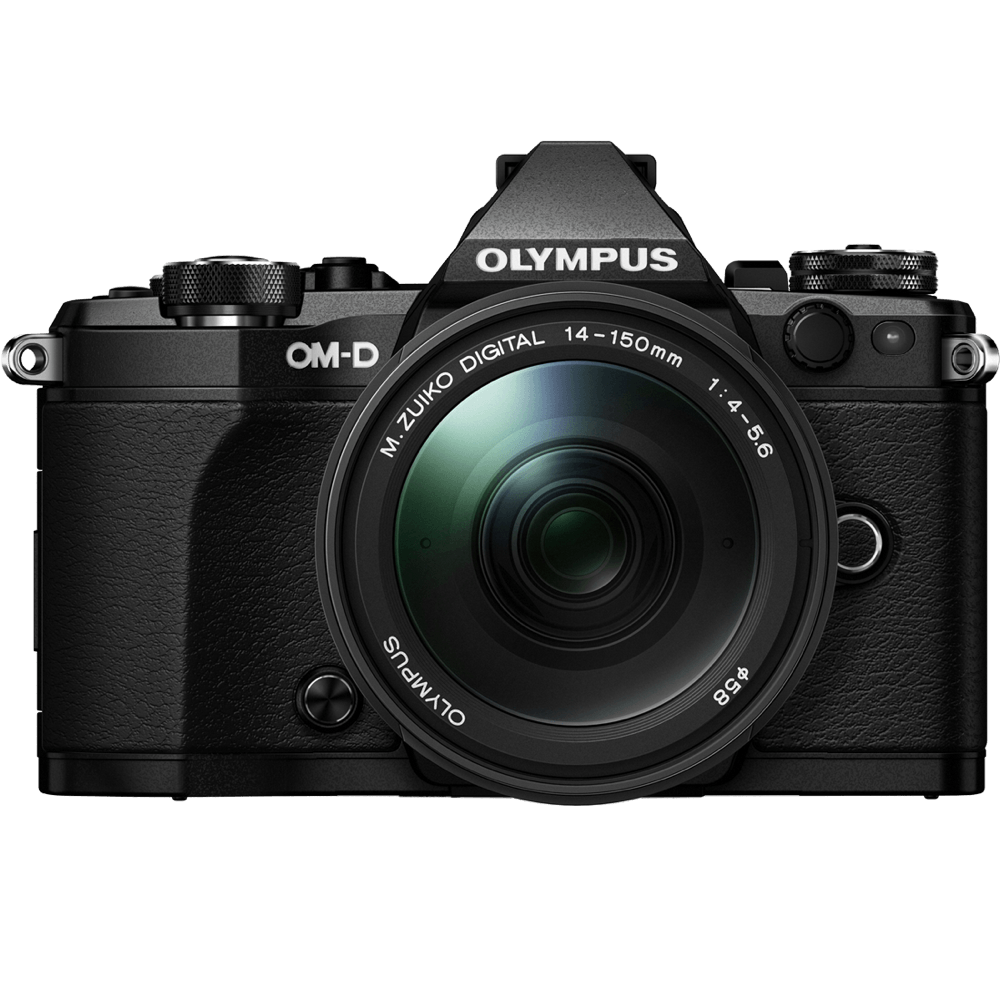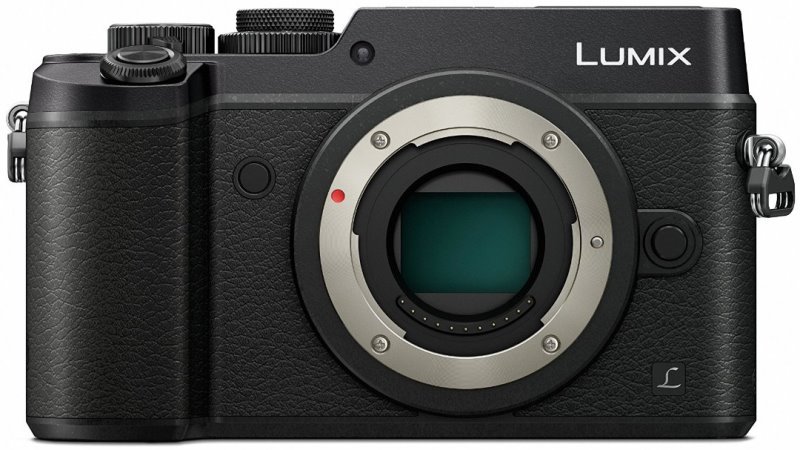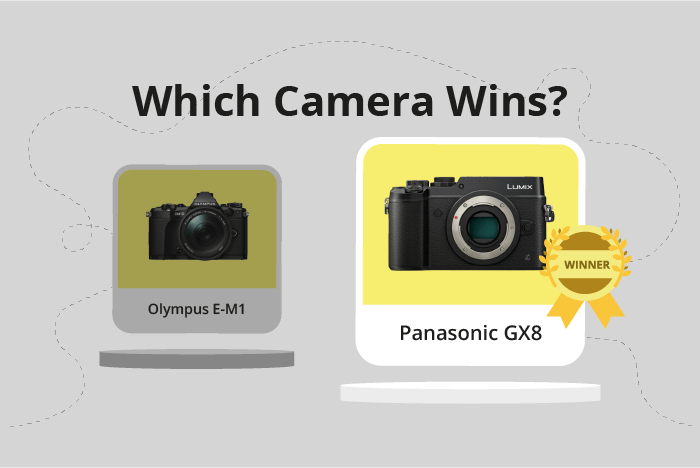Olympus OM-D E-M1 vs Panasonic Lumix DMC-GX8 Comparison
Olympus OM-D E-M1

Panasonic Lumix DMC-GX8

The Panasonic Lumix DMC-GX8 takes the lead in our comparison with a score of 63/100, while the Olympus OM-D E-M1 scores 59/100. Both cameras are mirrorless and were released in the mid-2010s, with the E-M1 in 2013 and the GX8 in 2015. They share similar dimensions, with the E-M1 measuring 130 x 94 x 63mm and the GX8 at 133 x 78 x 63mm.
The winning GX8 is not only lighter at 487g compared to the E-M1’s 497g, but it also has a lower launch price of $1200 against the E-M1’s $1399. However, the E-M1 stands out with its slightly more compact size, particularly in height. Ultimately, the Panasonic Lumix DMC-GX8’s higher score reflects its better overall performance and affordability, while the Olympus OM-D E-M1 offers a more compact design for those prioritizing portability.
Olympus OM-D E-M1 vs Panasonic Lumix DMC-GX8 Overview and Optics
The Panasonic Lumix DMC-GX8 emerges as the winner in the optics comparison with a score of 65/100, while the Olympus OM-D E-M1 trails behind at 58/100. Both cameras have several similarities, such as their 10 fps shooting speed, CMOS sensor type, Micro Four Thirds sensor size, Micro 4/3 lens mount, and image stabilization. These common features provide users with a solid foundation for capturing high-quality images.
The Lumix DMC-GX8 outperforms the OM-D E-M1 in two key areas: megapixels and the DXOMARK score. With 20.3 megapixels, the GX8 offers higher image resolution than the E-M1’s 16.3 megapixels, allowing for better detail and larger prints. Furthermore, the GX8’s sensor receives a DXOMARK score of 75, surpassing the E-M1’s score of 73. This indicates that the GX8’s sensor provides better overall image quality and low-light performance.
On the other hand, the Olympus OM-D E-M1 holds its own with its TruePic VII processor. While the GX8 is equipped with the Venus Engine processor, the E-M1’s TruePic VII processor is known for its fast performance and excellent image quality. This could potentially make the E-M1 a more responsive camera, despite having a lower overall optics score.
Taking these factors into account, the Panasonic Lumix DMC-GX8 proves to be the superior camera in terms of optics. Its higher megapixel count and better DXOMARK score contribute to its higher ranking. However, the Olympus OM-D E-M1’s TruePic VII processor should not be overlooked, as it may provide a faster and more responsive shooting experience. Ultimately, photographers should consider their specific needs when choosing between these two cameras.
Olympus OM-D E-M1 vs Panasonic Lumix DMC-GX8 Video Performance
The Panasonic Lumix DMC-GX8 outperforms the Olympus OM-D E-M1 in video capabilities, with a score of 70/100 compared to the E-M1’s 57/100. Both cameras share some common features such as the built-in time-lapse functionality, which allows users to create stunning time-lapse videos without requiring additional equipment or software.
The Lumix DMC-GX8 surpasses the E-M1 in terms of video resolution and dimensions. The GX8 boasts a 4K resolution, with video dimensions of 3840 x 2160, providing users with superior video quality and detail. This high resolution allows for more flexibility in post-production, as users can crop and reframe their footage without losing quality. However, the GX8’s maximum video frame rate is 25fps, which is slightly lower than the E-M1’s 30fps.
On the other hand, the Olympus OM-D E-M1 offers a maximum video resolution of Full HD (1920 x 1080). While this is lower than the GX8’s 4K resolution, it still provides good video quality for most users. The E-M1’s advantage lies in its higher maximum video frame rate of 30fps, which can result in smoother motion in videos, especially when capturing fast-moving subjects.
Taking these factors into account, the Panasonic Lumix DMC-GX8 is the superior choice for users who prioritize video quality and resolution, while the Olympus OM-D E-M1 may be more suitable for those who need a higher frame rate for smoother motion capture.
Olympus OM-D E-M1 vs Panasonic Lumix DMC-GX8 Features and Benefits
The Olympus OM-D E-M1 and the Panasonic Lumix DMC-GX8 both have a feature score of 70 out of 100, making them evenly matched in terms of features. These cameras share several specifications, such as a 3-inch screen size, touchscreen capability, flip screen, absence of GPS, WIFI connectivity, and no Bluetooth support.
The Olympus OM-D E-M1 has a screen resolution of 1,037,000 dots, which is slightly lower than the Panasonic Lumix DMC-GX8’s 1,040,000 dots. Despite this minor difference, both cameras provide users with clear and sharp images on their screens. The similar screen resolution ensures that users of both cameras can enjoy a satisfactory viewing experience.
While both cameras have their strengths, neither the Olympus OM-D E-M1 nor the Panasonic Lumix DMC-GX8 has a clear advantage in terms of features. The two cameras share many identical specifications, making it difficult to determine a superior choice based solely on their features.
When deciding between the Olympus OM-D E-M1 and the Panasonic Lumix DMC-GX8, potential buyers should consider other factors, such as price, design, and personal preference, as the cameras are equally matched in terms of features. By taking these additional factors into account, buyers can make a well-informed decision that best suits their needs and preferences.
Olympus OM-D E-M1 vs Panasonic Lumix DMC-GX8 Storage and Battery
The Olympus OM-D E-M1 and the Panasonic Lumix DMC-GX8 both score 21/100 in storage and battery, making them evenly matched in this aspect. Both cameras have a single memory card slot, accepting SD, SDHC, and SDXC cards. Neither camera offers USB charging.
The E-M1 edges ahead with a battery life of 350 shots, slightly outperforming the GX8, which has a battery life of 330 shots. The E-M1 uses the BLN-1 battery type, while the GX8 uses the DMW-BLC12.
Although the GX8 has a marginally shorter battery life, this difference is minimal and may not significantly impact users’ experiences.
In this comparison, both cameras display similar storage and battery capabilities, with the E-M1 having a slight advantage in battery life. The choice between these two cameras will depend on other factors, as their storage and battery performance are nearly identical.
Olympus OM-D E-M1 vs Panasonic Lumix DMC-GX8 – Our Verdict
Are you still undecided about which camera is right for you? Have a look at these popular comparisons that feature the Olympus OM-D E-M1 or the Panasonic Lumix DMC-GX8:

